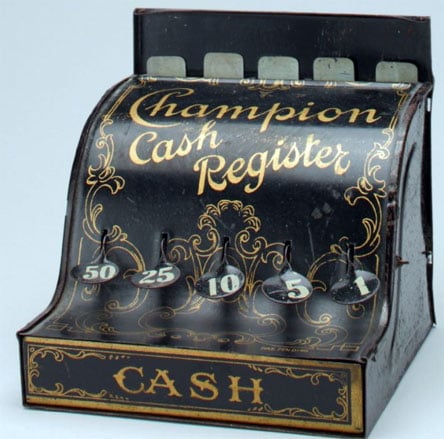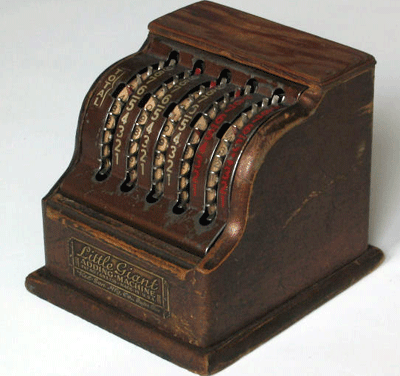Who Was John Pfeifer?
John Pfeifer was a bookkeeper and a remarkable inventor with over 60 patents to his name. Inventions he patented cut across calculating machines, cash registers, change-makers, grave vaults, Dictaphones, morgue tables, automatic curtain-hangers, signal devices, locks for automobiles, wrapping machines, etc.
Pfeifer’s first patent for an adding machine (US400359) was granted in 1889. It was for a five-column keyboard adding machine.
Early Life
John Pfeifer was born in Springfield, Ohio, on June 9, 1866, as the second son of Charles Pfeifer and Elizabeth Pfeifer (nee Berg). Charles (Carl) and Elizabeth (Elisabeth) were born in Germany and emigrated to the USA in 1864 together with their newborn son, Peter, who was also John’s elder sibling.
Initially, they settled in Pennsylvania but then established their home in Springfield, Ohio, where they birthed John and their other children between 1866 and 1877. John’s younger siblings were Caroline, Lizzie, Maggie, Adam, and Fred.
John Pfeifer studied at the public schools of Springfield and took courses in bookkeeping and mechanical drawing under the direction of private instructors. In 1881, at the age of fifteen, he entered an apprenticeship in the tool-making department of the St. John Machine Company, at Springfield.
Career
Phase 1
Four years after being an apprentice in the tool-making department of the St. John Machine Company, Springfield, John Pfeifer moved to Cincinnati and began to work with the Eclipse Sewing Machine Company. However, after a few months, he transferred his services to the Dueber Watch Works at Newport, Kentucky.
Phase 2
In 1887 he took a position with the Fay Watch Case Company, at Sag Harbor, Long Island, New York, where he acquired his first assignment as a foreman in the tool department.
Phase 3
John Pfeifer returned to Springfield in 1900 and became the foreman of the tool room of the St. John Sewing Machine Company, but two years later he went to Dayton and entered the employ of the famous National Cash Register Company of Patterson, in the tool department of the plant where he spent the next five years. He then re-entered the employ of the St. John Sewing Machine Company, and a year later he returned to Dayton with the National Cash Register Company, for which company he thereafter did important research and experimental work.
On his return to Springfield, Pfeifer organized a company for manufacturing the Champion Cash Register, which was invented and patented by him in the late 1890s. However, he sold these interests to the Mast & Foos Company after three years and joined this corporation in the capacity of superintendent of its cash-register department.

The company sold the cash-register business to the Toledo Computing Scales Company after two years of acquisition, causing Pfeifer to continue his connection with the latter company for the ensuing nine months.
From Toledo, John Pfeifer returned to Springfield, as the head of the tool room of the Foos Gas Engine Company. After two years he became the superintendent of the Standard Trimmer Company of this city. A year later he resumed his alliance with the Foos Gas Engine Company, as foreman of the tool room, and he advanced to the office of general superintendent of the plant, a position he retained for five years.
What Did John Pfeifer Invent?
Invention 1: The FIRST ADDING MACHINE OF John Pfeifer
Pfeifer’s first patent for adding machines (US400359) was granted in 1889. It was for a five-column keyboard adding machine.

Let’s examine the operation of the adding machine, using the patent drawing:
As each key is depressed the counting-wheel corresponding to the operating lever of the said key is moved to a number of notches represented on said key. As each counting wheel is revolved the number of notches which it moves is registered at the opening. When either counting wheel moves 10 notches, the next succeeding counting wheel and its indicating wheel are moved one notch.
In adding a column of figures the key in the units-row corresponding to each figure in the units-column is depressed, and the result will be registered by the indicating wheels through the openings.
The keys in the tens-row corresponding to each figure in the tens-column are then depressed with a similar result, the indicating wheel of the units column remaining unchanged while the other indicating wheels are moved corresponding to the numbers on the depressed keys.
The operation is continued for each column representing hundreds, thousands, etc., the result of any addition being disclosed by the indicating wheels as they appear at the openings above and in front of the keyboard.
Invention 2: Adder Little Giant
The Kel Sun Mfg. Co. in Dayton, Ohio produced one of Pfeifer’s patents for adding machines in the 1920s. The manufactured machine was named the Adder Little Giant, with patent number US No. 1663726.

The Adder Little Giant was shaped like a cash register and featured a small wooden case with dimensions: 16 x 14 x 13.5 cm.
Invention 3: Automatic Computing Scale
Pfeifer filed this patent, 1,707,683, on February 4, 1927, with “assignor of one-third to William G. Grim, of Springfield, OH. This invention was designed to improve upon automatic computing scales “of the pendulum type.”
The patent indicates that the scale would be “simple in construction, economical in manufacture and effective in operation.” It would provide a price chart and indicator, with the latter being arranged in such a manner that it would be easy to read. The indicator would also be used as a plumbing device to level the scale.
Other improvements included “…[A]n arrangement for mounting and operating the pan, which will eliminate binding of the parts” and “a simple arrangement for applying the load to the pendulum, including a peculiar 3 s 40 formation of the fulcrum end of the pendulum.”
Marriage
John Pfeifer married Lillian Bauer in 1889. His wife, Lillian was from Cincinnati and the daughter of Frederick Bauer.
Children
John’s marriage with Lillian Bauer only resulted in one offspring, Hazel. Hazel was born just a year after his parent’s marriage.
Death
John Pfeifer died on 29 April, 1939, and was buried in Ferncliff Cemetery, Springfield, OH.